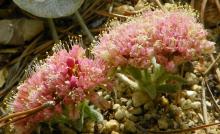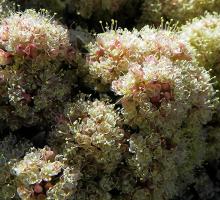Yes it's another of the High elevation buckwheats. Eriogonum lobbii found locally in the Sierra Nevada Range. This one grows in the Northern Sierras of CA & NV. It continues on a path across Northern CA to the coastal mountain Ranges were it just crosses the southern border of OR.
I have found this growing on Slide Mountain at 9500'-9700'. It is a low clumping/mat with rather large grayish green tomentose leaves and a long tap root. What what sets this alpine Eriogonum off from the rest is the way in which it displays it flowers. They are splayed out on the surface of the granitic scree around the plant. I have found two color forms white/cream or rosy/cherry. This seems to be easy to grow in the garden, given of course a well drained planting medium.
http://www.calflora.org/cgi-bin/species_query.cgi?where-calrecnum=9935
http://calphotos.berkeley.edu/cgi/img_query?where-genre=Plant&where-taxo...
http://www.plantsystematics.org/reveal/pbio/eriog/oligogonum/lobbii.html
http://plants.usda.gov/java/profile?symbol=ERLO2
http://www.efloras.org/florataxon.aspx?flora_id=1&taxon_id=250060369
http://ucjeps.berkeley.edu/cgi-bin/get_county_map.pl?taxon_id=24839&hcod...
The pictures will show both color forms. These are from the same population
Comments
Re: Eriogonum lobbii
You are correct. It is found on granitic and volcanic soils.
I find that many of the Erogenous found growing on specific soil types are not all that picky. I think they have developed the ability to grow were there is a lack of competition from grasses and sagebrush. I would call them opportunistic.
Lots of sun, good drainage and mineral soils with low in organic content seem to be what they want. They are very drought tolerant, the lower elevation species from western NV thrive on as little six inches of precipitation a year. A lot of them are found growing on slopes composed of a matrix of, volcanic rock and volcanically derived mineral clays. The high alpines of course are covered by heavy snow packs in winter and occasional light summer showers but the drainage is very sharp. These granitic screes are the texture of course loose sand.
Re: Eriogonum lobbii
Love the pictures - this really is one I shall look out for.
Re: Eriogonum lobbii
Me too!
John, you said buckwheats are easy from cuttings. It is more likely that I come across seeds than cuttings, so are they as easy from seeds as from cuttings?
Re: Eriogonum lobbii
Hoy
Yes they are easy from seed. As with most alpines cold stratification is the key. I use the typical lean gritty alpine mix in my pots. I sprinkle the seed over the top dressing, mist them down into the mix and set them out doors. Then let nature take it's course. I planted seed for seven Eriogonum species last year and had success with all of them. I got two to three plants of each species (plenty for my needs), out of ten seeds per pot sown.
I do not know if the ungerminated seed are on a multiple dormace cycles or not. My guess is that they are, given their natural habitats.
I have several species that have been in the garden for six years now. They are seeding around nicely on their own. As young plants I find them easy to transplant. I may lose one or two out of ten moved or potted up.
Re: Eriogonum lobbii
I have several species that have been in the garden for six years now. They are seeding around nicely on their own. As young plants I find them easy to transplant. I may lose one or two out of ten moved or potted up.
I too have had great success with both seeding around for certain species and the ability to transplant whilst they are young. My rock garden is very lean, being a mix of small gravel, sand, and very little soil. The seeds nestle down easily in the gravel mulch. Specific species that have seeded around for me are Eriogonum umbellatum humistratum (very choice leaf color), E. jamesii (not a surprise given they are native to my area), E gracilipes, and a few others.
Re: Eriogonum lobbii
This is one that hasn't been a stayer for me here in the northeast. Maybe three years was the longest it stayed, although it did flower. We don't have reliable snow cover in the winter and that may have something to do with it. Didn't get enough germination to try it in a variety of places but always grew it in a very coarse, fast-draining scree.
Re: Eriogonum lobbii
Sounds like my experience of germinating the seed is pretty much like other people. Lean mix, sow with only the least covering, leave in the cold for spring to come. My problem is getting any of them to flower which as yet none have. But I still love the plants and have to remember seeing them in the wild.
Re: Eriogonum lobbii
Sounds like my experience of germinating the seed is pretty much like other people. Lean mix, sow with only the least covering, leave in the cold for spring to come. My problem is getting any of them to flower which as yet none have. But I still love the plants and have to remember seeing them in the wild.
Malcolm, if you don't get them to flower, I certainly will not either! But I have to try - and the plants are decorative even without flowers too.
Re: Eriogonum lobbii
I have grown E. lobbii, where they were planted in ceramic pots and grown outside, lasting for 2-3 years, and actually flowered (modestly) with in a sort of burnished orange color. That was perhaps 10 years ago.
Re: Eriogonum lobbii
I have grown E. lobbii, where they were planted in ceramic pots and grown outside, lasting for 2-3 years, and actually flowered (modestly) with in a sort of burnished orange color. That was perhaps 10 years ago.
You have sunnier and warmer summers than I have!
Re: Eriogonum lobbii
Well Trond, in the summer you get sun for many more hours so perhaps that will help. I do not know why they don't flower, number of hours of light, temperature ...... or what
Re: Eriogonum lobbii
Well Trond, in the summer you get sun for many more hours so perhaps that will help. I do not know why they don't flower, number of hours of light, temperature ...... or what
I'll try again ...and again...and again if necessary!
Re: Eriogonum lobbii
Well Trond, in the summer you get sun for many more hours so perhaps that will help. I do not know why they don't flower, number of hours of light, temperature ...... or what
I'll try again ...and again...and again if necessary!
Perhaps experience from someone more or less in your part of the world might help. If I recall a recent conversation correctly, Peter Korn from Eskilsby, Sweden grows various Eriogonum successfully (which is to say, to flower). His website URL is http://www.peterkornstradgard.se. Go to his photo gallery to see a few in bloom. I find Peter very forthcoming with information.
Re: Eriogonum lobbii
I'll try again ...and again...and again if necessary!
Perhaps experience from someone more or less in your part of the world might help. If I recall a recent conversation correctly, Peter Korn from Eskilsby, Sweden grows various Eriogonum successfully (which is to say, to flower). His website URL is http://www.peterkornstradgard.se. Go to his photo gallery to see a few in bloom. I find Peter very forthcoming with information.
Thanks, Hugh. I did not know this site (No problem reading Swedish either). Seems that Peter has a small nursery too. Maybe he has some Erigeron to sell. The climate where he gardens is similar to where I have my summerhouse. (And that's where I plan to plant them.)
Re: Eriogonum lobbii
Peter has a wonderful nursery and a great garden with vast sandbeds - in Landvetter, some 20-30 km east of Gothenburg - and he grows the most amazing plants in the open. I want to get him to write for us sometime. Anyone visiting souther Swede should get to visit - even more impressive than the Botanic Garden !
Re: Eriogonum lobbii
Peter has a wonderful nursery and a great garden with vast sandbeds - in Landvetter, some 20-30 km east of Gothenburg - and he grows the most amazing plants in the open. I want to get him to write for us sometime. Anyone visiting souther Swede should get to visit - even more impressive than the Botanic Garden !
It is only 600km (373 miles) and about 9 hours drive from here! (Do you think Norway is a small country? Well, the roads are, anyway.) Still I'll try to go there some time.
Re: Eriogonum lobbii
He has a great open day at the beginning of his season with (for the past two years) an international speaker and food and so on and the whole place is great. That's the one to look for - this year it was called Nerd's Saturday and it was in April. Well worth going to if you can.
Re: Eriogonum lobbii
He has a great open day at the beginning of his season with (for the past two years) an international speaker and food and so on and the whole place is great. That's the one to look for - this year it was called Nerd's Saturday and it was in April. Well worth going to if you can.
Peter held another of his Speaker days this autumn.... Ian was one of the Speakers.... but I think that the event is so popular that Peter only needed "word of mouth" to get more than enough people attending.... so, if anyone would like to find out or attend a future event there I suggest that you make email contact with Peter and ask to be kept informed, in case wider announcements are not made...... 8)
Maggi
Re: Eriogonum lobbii
Just thought I'd show some updated photos of the color variation found in the Eriogonum lobbii population found on Slide Mountain, Washoe County, NV.
Re: Eriogonum lobbii
Thanks John for taking the time to find those excellent photos and post them, more buckwheat eye-candy to delight the senses.
Re: Eriogonum lobbii
It never fails to astound me just how many color variations there are to this choice buckwheat. Thanks John






You point out that this one grows in a granitic scree. Can I infer then that it does not require an alkaline soil?